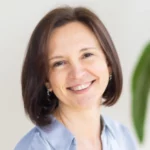Yoga for 3 Types of Digestive Discomfort

When you plan to use your yoga practice to aid digestion, images of deep twists might begin to crowd your mind. We’ve been conditioned to believe that twists are great for moving things along. This might be true in some cases, but it may be ill-advised in others.
When we encounter digestive issues, the first thing we do in yoga therapy is identifying the symptoms. Then we try to deduce what kind of qualities and direction of movement they represent. Based on that assessment, we chart a course of action to deal with the discomfort. Let’s take a look at the three most common scenarios.
How to Identify 3 Types of Digestive Discomfort

If somebody experiences an abdominal discomfort that’s accompanied by constipation, cramps, and bloating, in yogic interpretation this would mean that waste is having trouble moving downward. It also points to a hypo condition, when there is not enough activity in certain parts of the digestive tract.
In a situation like this, we would try to gently stimulate peristalsis (intestinal contractions), increase heat in the system (to fan the flames of agni, digestive fire), and generally use stronger movements with intentional abdominal contraction. Deeper twists might be appropriate here.

If somebody experiences a bellyache that is accompanied by diarrhea, agitation, and nervousness, we would say that the body is having trouble holding onto things. It also points to a hyper condition, when there is too much activity both in the digestive tract and the nervous system.
In that situation, we would focus on soothing the system, activating the parasympathetic response, and generally choosing more gentle movements and breathing practices. Some simple twists might still be effective, but our emphasis would be on releasing tension within the abdomen, rather than compressing it.
If somebody experiences irritable bowel syndrome (IBS) that is manifesting as abdominal pain, gas, diarrhea, or constipation, we would view it as an irritation and/or increased sensitivity within the system. We would try to calm the system down and reduce and/or eliminate the stress factors that contribute to its reactivity. Sometimes referred to as “spastic colon,” IBS is often linked to irregular contractions of the large intestine. If irregularity, in flare-ups and bowel movements, is an issue, we would seek to introduce rhythm and consistency with our asana and breathing practice.

How to Use Yoga to Help Alleviate Digestive Discomfort
As you can see, here we are less concerned with specific poses and movements and more with a particular effect they have on the system. There are several different spectrums that we would consider and ask ourselves the following questions:
- Do the symptoms indicate that the digestive system is overactive (hyper) or underactive (hypo)?
- Is there too much heat or too much coolness in the system?
- Is it stagnant or highly irregular?
In general, we try to figure out where on each spectrum the symptoms land, and then supplement the system with whatever it is missing in order to move it closer to the state of balance. That way we end up working with chemistry and energetics, rather than just general abdominal compression.

Also, read...
4 Easy Ways to Use a Sandbag in Yoga Practice
Exercise and Longevity: Diversify Your Yoga Practice for Maximum Benefits
Glute Amnesia: Yoga for Your Forgotten Rear
Related courses
Breath as Medicine: Yogic Breathing for Vital Aging
Yoga and Myofascial Release: Releasing Chronic Tension with the Bodymind Ballwork Method

Educated as a school teacher, Olga Kabel has been teaching yoga for over 14 years. She completed multiple Yoga Teacher Training Programs but discovered the strongest connection to the Krishnamacharya/ T.K.V. Desikachar lineage. She had studied with Gary Kraftsow and American Viniyoga Institute (2004-2006) and received her Viniyoga Teacher diploma in July 2006, becoming an AVI-certified Yoga Therapist in April 2011. Olga is a founder and managing director of Sequence Wiz— a web-based yoga sequence builder that assists yoga teachers and yoga therapists in creating and organizing yoga practices. It also features simple, informational articles on how to sequence yoga practices for maximum effectiveness. Olga strongly believes in the healing power of this ancient discipline on every level: physical, psychological, and spiritual. She strives to make yoga practices accessible to students of any age, physical ability, and medical history, specializing in helping her students relieve muscle aches and pains, manage stress and anxiety, and develop mental focus.



